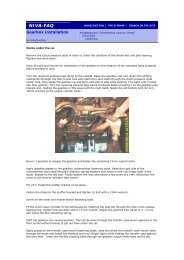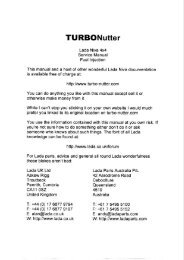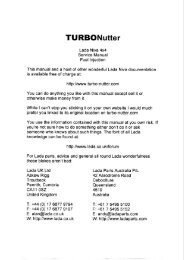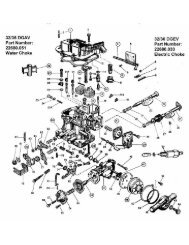You also want an ePaper? Increase the reach of your titles
YUMPU automatically turns print PDFs into web optimized ePapers that Google loves.
<strong>HORROR</strong>* 2 <strong>TBI</strong><br />
How a carburettor <strong>Niva</strong> was transformed into electronic<br />
injection<br />
by<br />
Mats Ahlberg, [AHMA]<br />
* = The infamous lambda-controlled carburetter is known as "The Horror Carb"<br />
1. Introduction ..........................................................................................................1<br />
1. About the contents of this document ..................................................................1<br />
2. Pros and cons......................................................................................................1<br />
3. Some decisions before starting...........................................................................2<br />
4. Tools, parts and skills needed.............................................................................2<br />
5. Planning..............................................................................................................5<br />
2. Here we go!............................................................................................................5<br />
3. Mounting ...............................................................................................................6<br />
4. Links ....................................................................................................................11<br />
Introduction<br />
About the contents of this document<br />
This is a simple write-up about one method to transform a carburettor <strong>Niva</strong> to throttle body<br />
injection. This is one possible way to do the job, there are probably just as many ways as there<br />
are inventive and talented mechanics out there. I hope it will inspire more to do the transplant,<br />
maybe give some guidance and also help in avoiding some of the traps on the way. As usual, in<br />
this kind of document, the author takes no responsibility for the contents, neither regarding safety<br />
nor the legal aspects.<br />
Pros and cons<br />
What do we win by replacing the carburetor engine with an EFI (electronic fuel injection)? Not<br />
all will agree, but this is my document, so.. I would say that the fuel injected engine will give<br />
you better performance under most conditions. The ECU (electronic control unit) analyses many<br />
more factors compared to the carburetor and does it best to give the engine optimal AFR (air fuel<br />
ratio) all the time. It "knows" pressure in intake manifold, intake air temperature, throttle
position, engine temperature, engine speed, vehicle speed and most important it monitors<br />
remaining oxygen in exhaust. All this info is processed and taken into consideration before ECU<br />
decides how to set injection and ignition. This will give you more power, lower fuel<br />
consumption and better response and control.<br />
So, is there a backside of the shining coin? Of course. Lots of information means lots of<br />
information sensors. This makes the system more vulnerable and more complicated to trouble<br />
shoot. You have to become friend with the multimeter - and maybe even to use diagnostic<br />
software. But, have no fear, we can solve most problems with just the multimeter and a<br />
paperclip. Even if we cant find the problem at once, the ECU will do the best it can to keep you<br />
mobile and to get you home. It will light up the "Check Engine" - but it will not let you down if<br />
you have to go on. Some will say that you will have problems finding spare parts - and that can<br />
be true, even if many parts are found on Opel/Vauxhall and other members of the GM family.<br />
On the other hand - there are very few moving parts in the <strong>TBI</strong> compared to the carb - so I would<br />
not worry too much about parts.<br />
Some decisions before starting<br />
To transform you Lada to fuel injection you can choose a few different paths. We will mention<br />
two briefly and then get going with the action. By the way - you have to use your imagination to<br />
understand this specific variation of English called "Swenglish".<br />
A. Use your 1600-engine and replace only the necessary parts. It's doable, but you will need a lot<br />
of parts from a 1.7 <strong>TBI</strong> engine so consider using the complete 1.7. The <strong>TBI</strong> system is optimised<br />
for 1.7 - but will probably word OK also on a 1600. This option can be done with engine in car.<br />
B. Use a complete 1.7 engine. Recommended. Makes everything much easier. This is the method<br />
described in this document.<br />
Next decision - getting a complete donor car or getting just the parts you need? Guess it is a<br />
matter about how tolerant your partner is considering status of driveway or backyard. I will list<br />
the things you need here, with some pics, so you should be able to use it as a shopping list and<br />
get just what you need. Who knows, maybe this document may save a marriage or two?<br />
Tools, parts and skills needed<br />
Tools first. Most of the work can be done with standard tools, but I will try to list a few "extras"<br />
that makes the job easier<br />
• rotating file, something like a big Dremel will help in enlarging some holes<br />
• chain pulley or engine crane to get the engine in and out.<br />
• O2-sensor long socket<br />
• 38 mm 3/8" socket with long handle for crank pulley
• multimeter<br />
• soldering tools<br />
Parts. This is what you need from the donor. MARK ALL LOOSE ENDS!:<br />
• a 1.7 <strong>TBI</strong> engine in good condition<br />
• the fuel tank from a 1.7 including fuel pump<br />
• the fuel ventilation stuff from rear inner wing (check black box for<br />
cracks)<br />
• the three fuel pipes from tank to engine bay including hoses<br />
• the fuel filter and the hoses that leads to and from <strong>TBI</strong>-unit<br />
• the completete GM wire harness for the <strong>TBI</strong><br />
• the coal cannister with PV, purge valve<br />
• the ignition unit (coil pac)<br />
• slotted crank pulley<br />
• cover with holder for CSS (crank speed sensor)<br />
• covers for distributor and fuel pump mountings<br />
• upper coolant pipe with CTS mounting<br />
• exhaust manifold with O2-sensor<br />
• "first" exhaust pipe<br />
• catalytic filter<br />
• intake manifold<br />
• throttle body unit<br />
• MAP manifold air pressure sensor<br />
• air cleaner box with ATS (air temperature sensor)<br />
• OA, Octane adjuster<br />
• the "twin drive" speed sensor cover from transfer box<br />
• VSS, vehicle speed sensor
• the Electronic Control Unit, ECU, with relays, diagnostic outlet, and<br />
fuses<br />
• cover for ECU (made from recycled yoghurt cans)<br />
• electric cooling fans with relay<br />
• accelerator pedal and cable<br />
• complete kit of seals, including crank shaft<br />
seals<br />
So, how difficult is it? Do you need to be a trained mechanic or could a happy Sunday hobbyist<br />
get away with it? I would say that you have to be average skilled. It does not take complicated<br />
machines or space rocket science, but you should feel comfortable with the idea to disconnect 30<br />
electric connections and with the other hand balance a 25 kilo gearbox while laying under the<br />
car. You get the idea?<br />
The time schedule is very much depending on how much you want to do while you "have the<br />
engine out". Cleaning engine, maybe giving the gearbox an overhaul or even paint the engine<br />
bay? There is a lot of work to do - and I would guess that two medium skilled mechanics could<br />
use at least two weekends for the job - doing just the minimum to make it work. Plus, there is<br />
always some vital part missing.
Planning<br />
The ideal is of course to prepare the 1.7 as much as possible before taking out the old 1600 and<br />
taking your <strong>Niva</strong> out of service. Giving the 1.7 a good maintenence is of course a good idea.<br />
New seals, maybe a new support bearing in flywheel, checking water pump, maybe replace the<br />
alternator with something beefier, maybe new timing chain and guidance and checking valve<br />
play under rocker cover.<br />
Clean all things up, indentify all electric connections, mark them.<br />
Make sure you have minimum of fuel in tank.<br />
Check and double check that you have all components, all tools and a plan B if your car does not<br />
get ready in time.<br />
Here we go!<br />
• disconnect battery<br />
• remove fuel tank and stuff in rear right wing<br />
• remove the three fuel pipes in centre tunnel (with gearbox out it is VERY easy..)<br />
• remove the three bolts for starter - take starter out halfway - disconnect two cables -<br />
remove starter<br />
• remove four bolts between bell housing and engine (double extenders and u-joint<br />
needed)<br />
• remove clutch slave cylinder<br />
• remove all wires to engine - MARK them!<br />
• remove fuel and vacuum hoses - burn them.<br />
• keep all coolant hoses for spares/emergency use<br />
• empty oil and coolant<br />
• remove radiator - careful, we will use it again.<br />
• release small coolant hoses to heater<br />
• remove carburettor<br />
• remove ignition coil, MARK wires + and -<br />
• remove ignition module (horror only)<br />
• remove AFR box under right seat and harness (horror only)<br />
• remove full load sensor (horror only)<br />
• remove exhaust manifold and exhaust inlcuding "first pipe"<br />
• remove nuts to engine rubber supports and to front diff.<br />
• support front diff to keep it from spinning<br />
• lift engine while supporting gearbox until engine snaps free from supports<br />
• wiggle and pull engine free from gearbox
• slowly lift engine while checking for forgotten wires and<br />
hoses<br />
Mounting<br />
• mount the three fuel lines, the hole in the floor under tank needs to be enlarged, a few<br />
mm forwards.<br />
• mount the new fuel tank and new vent hoses.
• Mount the "twin drive" for VSS on<br />
the transfer case<br />
• Reroute the wires to VSS and lead them out with wires for reverse gear<br />
• Mount the coilpac at a suitable<br />
position
• find a good home for the coal<br />
cannister<br />
• accelerator pedal is bolt-on
• ..and the accelerator cable fits in a hole after enlarging<br />
it<br />
• cooling fan (two for hot climates)
• lift the new engine into position and start connecting hoses and<br />
cables<br />
• get the oil pressure sensor and switch from the 1600 and mount it on the<br />
1.7<br />
• locate a good place to for the <strong>TBI</strong>-harness to pass into cabin
• the rest is about connecting wires and hoses, here is the GM-Lada interface<br />
• The blue (+B) should be connected to the wire that once was on ignition coil +.<br />
• There are two or three red wires that should be connected to battery +<br />
• There are several ways so solve the cooling fan - most simple is to use the belt driven<br />
fan from the 1600.<br />
• the tachometer will not work<br />
• Check Engine - you can use any 12V signal light<br />
Links<br />
You better face it - car projects are made for internet! Share your project and get some good<br />
advice in return<br />
www.turbo-nutter.com - all the manuals and papers you need<br />
http://www.lada.co.uk/forum/ - creme de la creme of English speaking Lada knowledge<br />
Baxter's Lada <strong>Niva</strong> site - a great collection of links, docs, pics, mods - open that toolbox!<br />
www.lada-niva.se - the home of the author - for <strong>Niva</strong> loving Vikings
















